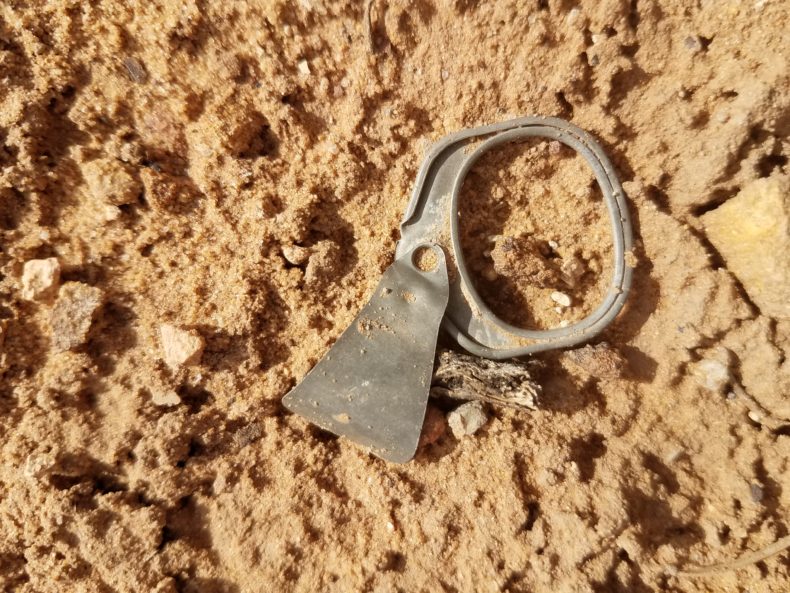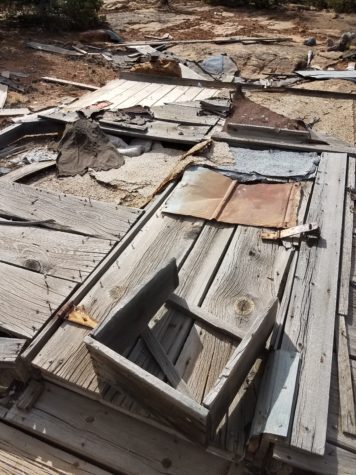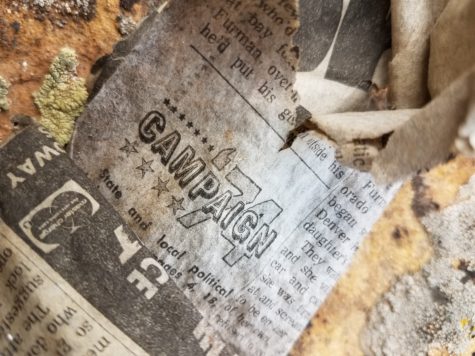 The other day I was going through someone’s collapsed house on the tip of a mesa in western Colorado. It looked like a small homestead where no one had been in a handful of decades. The front wall with its peaked roof and door still latched shut lay flat where it had fallen. I poked through nails and peeled off wallpaper, lifted a toppled wood-frame with the tip of my boot. Handle of a ceramic mug. Pull tab from a can. Shirt button.
The other day I was going through someone’s collapsed house on the tip of a mesa in western Colorado. It looked like a small homestead where no one had been in a handful of decades. The front wall with its peaked roof and door still latched shut lay flat where it had fallen. I poked through nails and peeled off wallpaper, lifted a toppled wood-frame with the tip of my boot. Handle of a ceramic mug. Pull tab from a can. Shirt button.
Whose life was this?
A small plastic coat hanger turned milky in the sun: kids or kid, a family, maybe a nice dress, or a Sunday shirt.
I’ve been doing this since I was little, playing archaeologist wherever people left their detritus. My grandpa and I used to drive around the plains of Chaves County, New Mexico, where he grew up, looking for barns and houses abandoned in one of the many lesser dust bowls to hit last century. We creaked in through doors half off their hinges and checked kitchen drawers and cupboards to see what had been left. I remember a corner of a photograph, a single wooden crutch.
I’ve never shaken the feeling I’m invading someone’s privacy. Even if they’ve been gone since long before I was born, it feels as if a shade of them is here, a memory lurking around. I learned to move slowly, quietly, a way of asking permission, or at least forgiveness.
At this abandoned house I left most things where they lay, a rusted Pennzoil can on its side, a sun-silvered bench made of old two-by-fours. There is no privacy for the dead, I thought. Splayed out in the sun, falling apart piece by piece, there’s nowhere to hide.
This is why I move slowly, why my demeanor changes. Maybe I shouldn’t be poking around at all, and I know it, so I calm my heart a little. Maybe it’s respect. One should behave differently in another’s home, even if long ruined.
I’ve been with archaeologists who talk the same way, questioning what it means to expose and remove someone else’s objects. An archaeologist who headed a Four Corners dig, an 11th century Chaco outlier, told me that when rattlesnakes started appearing, rattling from under a piece of plywood or between excavation buckets, she decided it was time to close the place, backfill the site. They’d gotten the maps and artifacts they needed, and it was good timing anyway. In private, she told me it was the rattlesnakes, so many of them appearing that she felt like she should pay attention. This was Pueblo ancestry, not her own, and she was keenly aware of her position as a visitor. A woman from one of the Pueblo tribes had come to visit and the archaeologist showed her the skeleton of a headless snake exposed on the floor of a ceremonial room. It had been placed there when the site was originally ‘abandoned’. Having been open and enthusiastic about the dig up until then, the woman turned around without saying anything and left.
This is what science as a discipline can easily miss. Private messages are in the ground, memories not yet gone. Whatever she saw was a direct message from a thousand years ago, still loud and clear as if no one ever left.
Whether it came from the fallen house or from my own imagination, I could feel the presence of a personal history as I wandered the grounds, finding where they dumped their trash, and the ruined remains of an outhouse, hand-chiseled curve in a plank where a butt cheek could sit. I wouldn’t gather its wood for a campfire or disturb its artifacts other than to pick them up and put them back down.
Maybe a cool bullet-shot can I’d take home, or a curious rusted spring. I consider an object to become archaeological around 60 years old. It’s the age in which a full generation has gone by, when the function of said rusted spring might have been forgotten. Others put it at 75 to 100 years.
How old was this site? In a rock crack were sun-grayed pages of the Denver Post. Pulled out and unfolded, like undoing origami, they revealed an ad for “False Teeth” across from classifieds, Fantasy Girls at the Bluebird, “model studios” with “luscious kittens” at Kitty’s, and, in a decayed crease, Linda Lovelace starring in “Deep Throat,” putting it back to when I was a kid. I turned a shredded page and found “CAMPAIGN ’74.”
Now I had a time bracket. I saw bell bottoms and curlers. I conjured faces, laughter, conversations into the night. The front door swung opened and closed, people coming and going, slammed out of anger, latched quietly so as not to wake the kids. Would they have minded my exploration? I picked up a pull tab, imagining the finger that hooked through it, the person on the other end cracking a beer on a warm day, and I put it back.
Photos: Craig Childs
I love and always appreciate Craig’s view and words on our past. My uncle Stan South, a renowned pioneer in historical archaeology, was fascinated as a child while following his grandmother exploring old abandoned homesites. She told him stories of who and what might have been there, lighting in him a fire that would be his life’s love and work.
Once, a colleague found an old, goldenrod colored case file from the 1950’s, it’s case notes written in blue ink. This was back in the days when Child Welfare was just “The Welfare Office.” Who were these caseworkers who’s hands touched thesee pages? Images were conjured of a woman in her mid-30’s, banging out notes on an old Underwood, or feverishly writing with a fountain pen, pack of Lucky Strikes, ashtray full, coffee cold.
Hi Craig – I enjoyed meeting and reading with you at the Paonia Voices event last fall. I especially enjoyed this piece as I too like to walk among old, abandoned homesites. I pick up glass – especially colored glass. Most of the time the glass is in shards and pieces. My reasoning is I don’t want wildlife to step on it, but I also see beauty in something that has mostly been replaced by plastic. I piece together art forms, which I line-up in the windows of my home. When the sun hits these pieces, it gives new life to old glass. I set-up a page on my finds. I hope the rattlesnakes’ don’t mind. https://www.facebook.com/snowpackpublicrelations/?ref=bookmarks